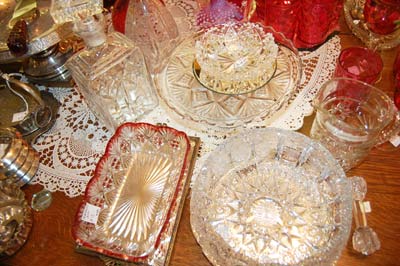Speaking of Antiquing – with Margaret Barnes, Pickety Place Antiques & Collectibles
In the early 1900’s you could scarcely open a newspaper or magazine without seeing an advertisement for Brilliant Cut Glass. In the form of a vase, ice cream dish, a goblet, or fruit bowl, several glass companies wanted the consumer to buy their beautiful cut glass items for the bride or for Christmas gifts.
These items were loved and passed down through the generations. Many of you will remember looking into your mother’s or grandmother’s china cabinet (you know, the one with the huge “HANDS OFF” signs) and seeing the pretty cut glass dish sitting there.
Maybe she brought it out at Holiday time to put candy in, or cranberry sauce. Maybe she never used it because it was just too precious.
If you are on the lookout for some lovely cut glass items but really don’t know how to tell cut glass from pressed glass, let me give you a few simple clues.
Hold the piece up to a light. Are there seam lines? Glass from a mold often has seams which show as lines in the finished product. If there are mold lines, then it’s not cut glass.
Is it heavy or light? Cut glass pieces are usually heavier than pressed glass pieces because the glass needed to be thicker to make deep cuts where a pressed piece required only a thin layer to flow into the mold and create intricate designs.
Tap the rim. Does it give a pleasing ring or a dull thud? Lead crystal is heavier and gives a distinctive ringing sound when lightly tapped. Pressed glass will have a dull sound when tapped.
Rub your hand over the body of the piece. Is it sharp or soft? On a true cut glass item, the design will be consistently crisp and sharp. The cut glass will feel sharp, as if it might cut your hand. The better the piece the deeper the cuts will be. The pressed piece will feel smooth and the cuts shallow.
Is it shiny? The grooves in the glass were cut to allow more light reflecting surfaces. This gave a high brilliance and if you hold it to the light you will be able to see rainbows. A pressed piece will not have this sparkle.
The popularity of cut crystal glass has never died, and today there are major glassworks specializing in high-quality, hand-cut crystal such as Baccarat in France or Waterford in Ireland and Webb Corbett in England.
Most of the higher quality pieces were signed, or etched on the bottom. Look for items from Clark, Hawkes, Libby, Tuthill, and others.
The saying is very true that you get what you pay for. So back in the 1900’s a vase for $4 might have been an expensive item, but the quality of the item and the pleasure it gives the owner does not fade.
I like to say, “If you have it, use it.”
It will be more pleasing than it sitting in your cabinet with a “HANDS OFF” sign!

 Margaret Barns is co-owner of Pickety Place Antiques & Collectibles located at 130 N. 4th Street in Jacksonville. LIKE them on
Margaret Barns is co-owner of Pickety Place Antiques & Collectibles located at 130 N. 4th Street in Jacksonville. LIKE them on